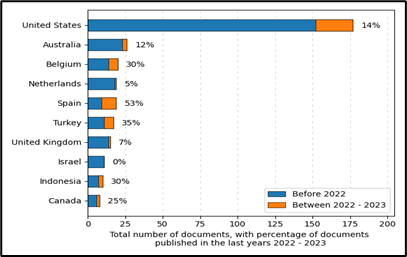Publication trends on proportional reasoning research: A bibliometric analysis using Scopus database
DOI:
https://doi.org/10.33830/ijdmde.v1i2.9474Keywords:
Bibliometric, Propotional reasoning, ScopusAbstract
Proportional reasoning ability is an important ability for students to understand mathematical concepts. Much research has been conducted on this capability, but it is necessary to map existing research to provide a clearer picture of future research topics. This research aims to provide a bibliometric overview of trends in the use of proportional reasoning skills in mathematics teaching research. The method in this research is bibliometric analysis, which aims to analyze and classify bibliographic material by presenting a representative summary of literature in the Scopus database. The search was carried out using the keyword "proportional reasoning" in the search menu in the Scopus.com database. ScientoPy software analyzes the author's name, number of document citations, document title, publication year, document source, publisher, and document type Research trends in proportional reasoning show a significant increase, with 356 publications in Scopus, peaking at 32 in 2023. Major contributors include the United States, Turkey, and Spain, with recent studies focusing on "teacher knowledge." Influential works by Liberali et al., Atkinson et al., and Tobin & Capie address numeracy, multimedia learning, and logical thinking, respectively. These findings suggest that improving teacher knowledge and using effective multimedia tools could enhance instruction and research in proportional reasoning. Future research should explore innovative teaching strategies and technologies to further advance proportional reasoning ability.
References
Ahyan, S., Turmudi, T., & Juandi, D. (2021). Bibliometric analysis of research on mathematical literacy in Indonesia. Journal of Physics: Conference Series, 1869(1), 12120. https://doi.org/10.1088/1742-6596/1869/1/012120
Arıcan, M. (2019). A diagnostic assessment of middle school students’ proportional reasoning. Turkish Journal of Education, 8(4), 237–257. https://doi.org/10.19128/turje.522839
Atkinson, R. K., Mayer, R. E., & Merrill, M. M. (2005). Fostering social agency in multimedia learning: Examining the impact of an animated agent’s voice. Contemporary Educational Psychology, 30(1), 117–139. https://doi.org/10.1016/j.cedpsych.2004.07.001
Booth, J. L., Newton, K. J., & Twiss-Garrity, L. K. (2014). The impact of fraction magnitude knowledge on algebra performance and learning. Journal of Experimental Child Psychology, 118, 110–118. https://doi.org/10.1016/j.jecp.2013.09.001
Boyer, T. W., & Levine, S. C. (2012). Child proportional scaling: Is 1/3=2/6=3/9=4/12? Journal of Experimental Child Psychology, 111(3), 516–533. https://doi.org/10.1016/j.jecp.2011.11.001
Boyer, T. W., Levine, S. C., & Huttenlocher, J. (2008). Development of Proportional Reasoning: Where Young Children Go Wrong. Developmental Psychology, 44(5), 1478–1490. https://doi.org/10.1037/a0013110
Burgos, M., Beltrán-Pellicer, P., & Godino, J. D. (2020). The issue of didactical suitability in mathematics educational videos: Experience of analysis with prospective primary school teachers. Revista Espanola de Pedagogia, 78(275), 27–49. https://doi.org/10.22550/REP78-1-2020-07
Çoban, H., & Tezci, E. (2022). Mathematical reasoning: Bibliometric analysis of the literature. OPUS Journal of Society Research, 19(45), 88–102. https://doi.org/10.26466/opusjsr.1062867
de Queiroz, A. P. (2021). Spatial thinking: A bibliometric analysis (1970–2019). Geographical Reasoning and Learning: Perspectives on Curriculum and Cartography from South America, 111–122.
Hansen, N., Jordan, N. C., Fernandez, E., Siegler, R. S., Fuchs, L., Gersten, R., & Micklos, D. (2015). General and math-specific predictors of sixth-graders knowledge of fractions. Cognitive Development, 35, 34–49. https://doi.org/10.1016/j.cogdev.2015.02.001
Hoyles, C., Noss, R., & Pozzi, S. (2001). Proportional Reasoning in Nursing Practice. Journal for Research in Mathematics Education, 32(1), 4–27. https://doi.org/10.2307/749619
Jeong, Y., Levine, S. C., & Huttenlocher, J. (2007). The development of proportional reasoning: Effect of continous versus discrete quantities. Journal of Cognition and Development, 8(2), 237–256. https://doi.org/10.1080/15248370701202471
Jumareng, H., Setiawan, E., Supriyadi, E., Sugiarni, R., Abdullah, K. H., Gazali, N., Ridwan, M., Demir, G. T., & Hofmeister, M. (2024). Research trends in sports sciences in Indonesia: A bibliometric analysis. Jurnal Keolahragaan, 12(1), 77–86.https://doi.org/10.21831/jk.v12i1.69568
Khoeriah, I. A., Permana, I., & Ardianto, D. (2022). Science Reasoning: A Review and Bibliometric Analysis. Jurnal Penelitian Pendidikan IPA, 8(2), 423–428. https://doi.org/10.29303/jppipa.v8i2.1135
Lamon, S. J. (2007). Rational numbers and proportional reasoning: Toward a theoretical framework for research. The Second Handbook of Research on Mathematics Teaching and Learning, 1, 629–668. https://doi.org/10.1007/s10763-010-9249-9
Liberali, J. M., Reyna, V. F., Furlan, S., Stein, L. M., & Pardo, S. T. (2012). Individual Differences in Numeracy and Cognitive Reflection, with Implications for Biases and Fallacies in Probability Judgment. Journal of Behavioral Decision Making, 25(4), 361–381. https://doi.org/10.1002/bdm.752
Mahmudin, M., Herman, T., Supriyadi, E., Iskandar, R. S. F., & Sugiarni, R. (2023). Analisis bibliometrik literasi matematika dalam database scopus menggunakan vosviewer. AKSIOMA: Jurnal Program Studi Pendidikan Matematika, 12(3), 3213–3230. https://doi.org/10.24127/ajpm.v12i3.6832
Muhammad, I., Rusyid, H. K., Maharani, S., & Angraini, L. M. (2024). Computational Thinking Research in Mathematics Learning in the Last Decade: A Bibliometric Review. International Journal of Education in Mathematics, Science and Technology, 12(1), 178–202. https://doi.org/10.46328/ijemst.3086
Pişkin Tunç, M., & Çakıroğlu, E. (2022). Fostering prospective mathematics teachers’ proportional reasoning through a practice-based instruction. International Journal of Mathematical Education in Science and Technology, 53(2), 269–288. https://doi.org/10.1080/0020739X.2020.1844909
Scheibling-Sève, C., Gvozdic, K., Pasquinelli, E., & Sander, E. (2022). Enhancing Cognitive Flexibility Through a Training Based on Multiple Categorization: Developing Proportional Reasoning in Primary School. Journal of Numerical Cognition, 8(3), 443–472. https://doi.org/10.5964/jnc.7661
Spinillo, A. G., & Bryant, P. (1991). Children’s proportional judgments: The importance of “half.” Child Development, 62(3), 427–440. https://doi.org/https://doi.org/10.1111/j.1467-8624.1991.tb01542.x
Suseelan, M., Chew, C. M., & Chin, H. (2022). Research on Mathematics Problem Solving in Elementary Education Conducted from 1969 to 2021: A Bibliometric Review. International Journal of Education in Mathematics, Science and Technology, 10(4), 1003–1029. https://doi.org/10.46328/ijemst.2198
Tobin, K. G., & Capie, W. (1981). The development and validation of a group test of logical thinking. Educational and Psychological Measurement, 41(2), 413–423. https://doi.org/10.1177/001316448104100220
Van Dooren, W., De Bock, D., Hessels, A., Janssens, D., & Verschaffel, L. (2005). Not everything is proportional: Effects of age and problem type on propensities for overgeneralization. Cognition and Instruction, 23(1), 57–86.https://doi.org/10.1207/s1532690xci2301_3
Warshauer, H. K. (2015). Productive struggle in middle school mathematics classrooms. Journal of Mathematics Teacher Education, 18(4), 375–400. https://doi.org/10.1007/s10857-014-9286-3

Downloads
Published
How to Cite
Issue
Section
License
Copyright (c) 2024 Rani Sugiarni, Khairul Hafezad Abdullah

This work is licensed under a Creative Commons Attribution-ShareAlike 4.0 International License.









